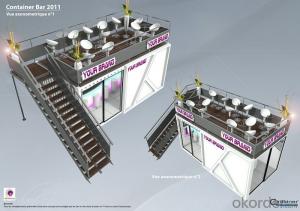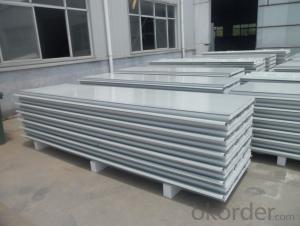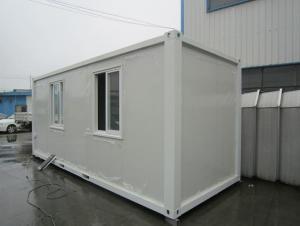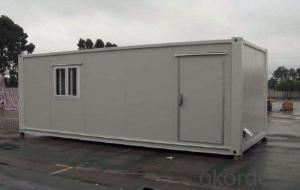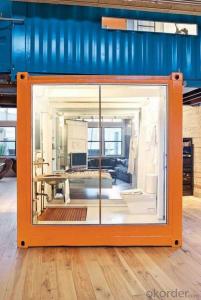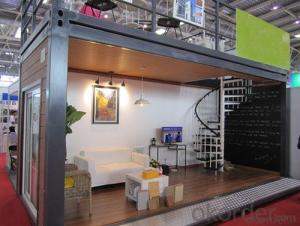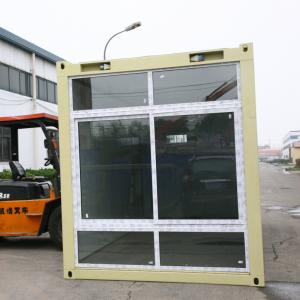Good Quality Container House Made in China with CE Certificate
- Loading Port:
- Tianjin
- Payment Terms:
- TT OR LC
- Min Order Qty:
- 3 set
- Supply Capability:
- 500 set/month
OKorder Service Pledge
OKorder Financial Service
You Might Also Like
Good Quality Container House Made in China with CE Certificate
1. The benefits of Container House
Perfect for modular/prefab site offices,cabins,warehouse,villa,toliet,shop,hotel,camp,office
Efficient, low cost designs that can be customized for end user requirements
Easy for low skilled workers to assemble
The light steel frame structure is strong and reliable
Many modular homes can be stacked and linked together to create more space
Neat inside: plumbing and wires are hidden into the sandwich panel
2. Certificates:
ISO9001, ISO14001, CSA(Canadian Standards Association), CE(European Conformity), AU(Australia Standard),UL(America standard)
3. Specification:
Item | Specification |
Frame | Cold formed 3-4mm Steel Profile Wind resistance capacity>120km/h, Seismic resistance capacity > grade 8 |
Floor | ·0.5 mm flat galvanized steel sheet ·100mm non combustible mineral wool ·18mmplywood panel ·Customized PVC floor |
Roof | 0.5mm galvanized &painted steel sheet ·100mm non combustible mineral woo ·one set CE electronic installation |
Door | ·Single fold, 40mm thick ·Insulated with PL (polystyrene) · Opening dimensions of 808×2030mm, with a handle lock with 3 keys. · Net opening dimensions: 754 x 1985 mm. |
Wall panel | ·0.5mm galvanized &painted steel sheet ·60mm rock wool ·9mm chipboard |
Window | Made of PVC, white color, with dimensions 800×1100mm, glazed with double layer glass with sliding mechanism (one side fixed and one sliding). More extra types chosen in term of your specific needs. |
The cabin can be dis-assemebled for transport.
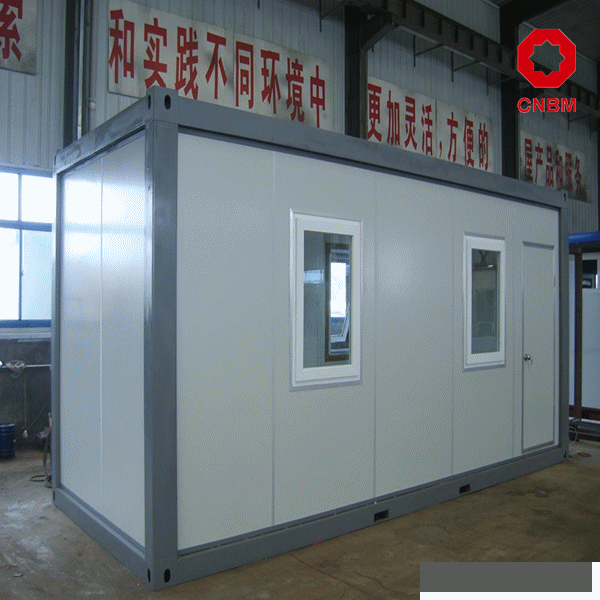

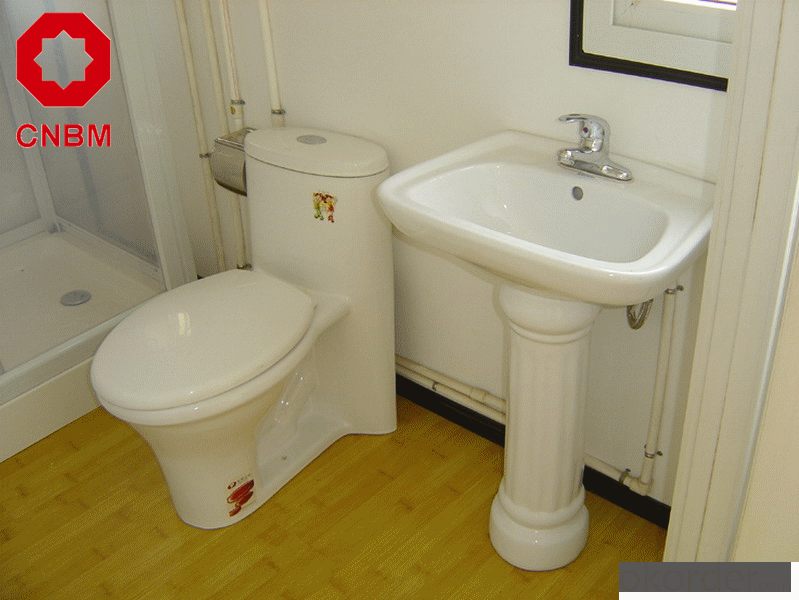
- Q:Are container houses energy-efficient?
- Yes, container houses can be energy-efficient. They are designed to provide good insulation, reducing the need for heating and cooling. Additionally, container houses can incorporate energy-efficient systems such as solar panels, LED lighting, and energy-efficient appliances, further reducing energy consumption.
- Q:Can container houses have traditional interiors?
- Yes, container houses can have traditional interiors. With proper design and customization, container houses can be transformed to have traditional aesthetics and features such as wooden finishes, vintage furniture, ornate decorations, and classic color schemes. By incorporating traditional elements, container houses can blend modern construction with a traditional interior design style, creating a unique and personalized living space.
- Q:Can container houses be built with a traditional bedroom layout?
- Yes, container houses can be built with a traditional bedroom layout. While container houses are often associated with more minimalist and open floor plans, they can certainly be designed to accommodate traditional bedroom setups. With proper planning and creative design, containers can be modified to include separate bedrooms, complete with walls, doors, windows, and even traditional furniture like beds, wardrobes, and bedside tables. One approach to creating a traditional bedroom layout in a container house is to stack or combine multiple containers to increase the available space. By connecting containers vertically or horizontally, one can create larger rooms that can easily accommodate a bedroom layout with enough space for a bed, furniture, and closet space. Another option is to design the container house with a combination of container and traditional construction techniques. This allows for more flexibility in layout and provides the opportunity to create designated bedrooms with walls that separate them from the rest of the house. It is important to keep in mind that container houses have certain limitations in terms of size and structural integrity. However, with proper planning and professional architectural and engineering expertise, it is definitely possible to build a container house with a traditional bedroom layout that meets your needs and preferences.
- Q:Are container houses suitable for remote or off-grid workspaces?
- Yes, container houses are suitable for remote or off-grid workspaces. They can be easily transported to remote locations and provide a secure and comfortable workspace. Additionally, container houses can be customized with various amenities, such as solar panels and water collection systems, making them self-sufficient and ideal for off-grid work environments.
- Q:Are container houses suitable for religious or spiritual retreats?
- Certainly, container houses are indeed suitable for religious or spiritual retreats. These exceptional structures offer a range of benefits that make them attractive for this purpose. Firstly, container houses are often designed with sustainability in mind, which aligns perfectly with the values held by many religious and spiritual retreats that place importance on living in harmony with nature. Additionally, the modular nature of container houses allows for flexibility in design, enabling retreat organizers to create spaces that promote meditation, reflection, and prayer. Moreover, container houses can be easily transported to remote or secluded areas, providing retreat participants with a tranquil and serene environment. Furthermore, the cost-effectiveness of container houses in comparison to traditional buildings can make religious or spiritual retreats more accessible to a wider range of individuals. All in all, container houses offer a practical and innovative solution for establishing meaningful and sacred spaces for religious or spiritual retreats.
- Q:Are container houses legal?
- Container houses are legal in numerous locations worldwide, yet the specific regulations and requirements may differ depending on the particular area. Some regions view container houses as viable housing alternatives and impose the same building codes and permits as traditional homes. Nevertheless, certain areas may impose restrictions or necessitate additional permits for container houses due to specific zoning regulations or aesthetic concerns. Therefore, it is crucial to consult local building authorities and acquaint oneself with the local regulations and requirements prior to commencing the construction of a container house.
- Q:Can container houses be expanded?
- Yes, container houses can be expanded. One of the advantages of using shipping containers for housing is their modular nature, which makes it relatively easy to add additional containers to increase living space. These containers can be stacked or joined together to create multi-level or larger living areas. Additionally, container houses can also be expanded horizontally by adding new containers next to the existing ones. The flexibility of container homes allows for various expansion options, making them a versatile and convenient choice for those looking to increase their living space.
- Q:Are container houses suitable for student accommodation?
- Indeed, container houses can serve as a viable choice for student accommodation. They possess several merits that render them appealing to students. Firstly, container houses prove cost-effective in comparison to traditional housing alternatives, a crucial aspect for students who often possess limited budgets. They can be procured or rented at a reduced expense, thereby constituting a more economical alternative. Secondly, container houses boast high degrees of customization, allowing for their transformation into cozy living spaces. With suitable modifications, these houses can encompass all the essential amenities, including bedrooms, bathrooms, kitchens, and study areas. By optimizing space utilization, these structures can furnish a comfortable living environment for students. Furthermore, container houses present the advantage of being portable, facilitating easy relocation if necessary. This flexibility proves advantageous to students who may frequently need to move, be it due to university transfers, internships, or other reasons. By enabling transportation to different locations, container houses offer a convenient solution for student accommodation. Moreover, container houses demonstrate an eco-friendly nature, given that they are constructed from recycled shipping containers. Consequently, they represent a sustainable and environmentally conscious choice for student housing. As the emphasis on sustainability continues to grow, container houses align with the values of numerous students concerned about the environment. However, it is crucial to acknowledge potential drawbacks as well. Container houses may possess limited insulation, potentially necessitating additional heating or cooling measures. They might also present restricted space in comparison to traditional houses, which could pose a concern for students requiring more room. Additionally, the availability of land and requisite permits for container houses can vary depending on the location, potentially posing challenges for student accommodation. In conclusion, container houses offer a fitting option for student housing due to their affordability, customizability, portability, and eco-friendliness. While certain limitations should be considered, these houses present a practical and sustainable solution for students seeking affordable and flexible housing alternatives.
- Q:Can container houses be designed to have a wheelchair ramp?
- Yes, container houses can definitely be designed to have a wheelchair ramp. The beauty of container houses is that they can be customized and modified according to the specific needs and requirements of the inhabitants. The design and installation of a wheelchair ramp can be seamlessly integrated into the structure of a container house, ensuring accessibility for individuals with mobility challenges. There are various ways in which a wheelchair ramp can be incorporated into a container house design. One option is to have a ramp built on the exterior of the house, leading to the entrance. This can be achieved by creating a gradual slope or by installing a foldable ramp that can be extended and retracted as needed. Alternatively, the interior of the container house can also be adapted to include a ramp. This can be achieved by modifying the floor plan to have a gentle incline or by installing a platform lift that can raise or lower the wheelchair to different levels within the house. In both cases, it is important to ensure that the ramp meets all safety standards and regulations. This includes considering factors such as the width, length, and gradient of the ramp, as well as the use of handrails and non-slip surfaces. Ultimately, container houses offer great flexibility when it comes to design and customization. With the right planning and modifications, wheelchair ramps can be easily incorporated into the overall design of a container house, allowing for easy accessibility and enhanced quality of life for individuals with mobility challenges.
- Q:Are container houses prone to pests or insects?
- The susceptibility of container houses to pests or insects varies depending on multiple factors. Firstly, the location of the container house plays a pivotal role. If it is situated in an area abundant with pests or insects, the chances of encountering such issues are higher. Secondly, the condition of the container itself is crucial. Should there be gaps, cracks, or other openings, pests may infiltrate. Nevertheless, by implementing adequate insulation, sealing, and regular maintenance, the risk of pests or insects entering can be significantly diminished. Furthermore, the lifestyle and habits of the occupants also impact the likelihood of pest infestations. Regular cleaning, proper waste management, and maintaining an uncluttered environment are essential practices that aid in deterring pests from being attracted to the container house. It's important to note that container houses are not inherently more susceptible to pests or insects when compared to traditional houses. In fact, due to their construction material, typically steel, container houses may be less vulnerable to certain pests, such as termites, which can cause extensive damage to wooden structures. To ensure a pest-free environment in a container house, it is advisable to seek guidance from a pest control professional who can offer tailored recommendations based on the location, climate, and potential pest risks. By taking proper precautions and proactive measures, container houses can be just as free from pests as any other type of dwelling.
1. Manufacturer Overview |
|
|---|---|
| Location | |
| Year Established | |
| Annual Output Value | |
| Main Markets | |
| Company Certifications | |
2. Manufacturer Certificates |
|
|---|---|
| a) Certification Name | |
| Range | |
| Reference | |
| Validity Period | |
3. Manufacturer Capability |
|
|---|---|
| a)Trade Capacity | |
| Nearest Port | |
| Export Percentage | |
| No.of Employees in Trade Department | |
| Language Spoken: | |
| b)Factory Information | |
| Factory Size: | |
| No. of Production Lines | |
| Contract Manufacturing | |
| Product Price Range | |
Send your message to us
Good Quality Container House Made in China with CE Certificate
- Loading Port:
- Tianjin
- Payment Terms:
- TT OR LC
- Min Order Qty:
- 3 set
- Supply Capability:
- 500 set/month
OKorder Service Pledge
OKorder Financial Service
Similar products
New products
Hot products
Related keywords
